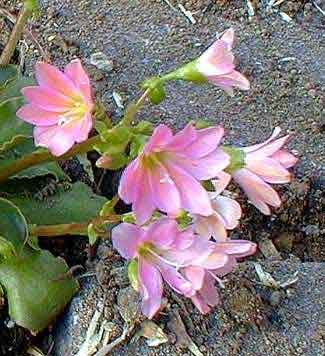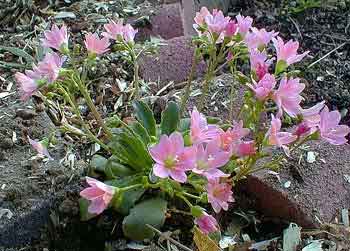 Pale Pink Lewisia; or,
Pale Pink Lewisia; or,
Pink Cliff Maids
"In the hope of reaching the moon
men fail to see the flowers
that blossom at their feet."
-Albert Schweitzer
(1875-1965)
(1875-1965)
Over its extensive but much-interupted range along the Pacific Northwest coastal mountains, Lewisia cotyledon has extraordinary variation in color, from white to the richest deepest rose-pink. But pale pink is the most common color seen in the wild. Our pale pink is by no means like the wild form, however, because the flowers are softer & much larger for this intraspecies hybrid.
Many of the specimens we have came from Rare Plants Research near Portland, Oregon. One of their goals is to protect our native species by taking pressures of the wild populations, providing affordable cultivated specimens. The secondary plus for gardeners is that select strains are especially floriferous, & color intensity is encouraged by selecting seed from preferred specimens.
It is impossible ever to know the hybrid history of these specimens, as every strain seems to have an amazing variations of leaf appeareance. But the leaves are about as wide as they ever geet on L. cotyledon & mildly wavy, suggestive of L. cotyledon howellii as part of its hybrid make-up. One of our lewisias purchased definitely as a Howell's has the same leaf & even the same pale pink flower, but its flowers are larger & have split petals (for comparisons, see it pictured on the Howell's Lewisia Split Pink page). So I have identified this one as another Howell's, though if ever seedlings could be gotten from it, there is no reason to suppose it would look the same, as hybrids are not predictable to subspecies type.
This little Lewisia grows under a Staghorn Sumac where it is usually in full bloom well before the end of April, a couple weeks ahead of the majority in the same garden. The Lewisias generally start blooming before April's end, & a few will have already bloomed tepidly since March; but the majority will be at their height of flower starting May. It's nice to have a few that get a jump on the others, extending the already long time-period for Lewisia flowers. Some last to the end of summer, but even in a single garden under identical conditions, this varies from plant to plant. As a very uneasy generality with too many exceptions, the ones with smaller flowers bloom a little ahead of specimens with bigger flowers.
 The flowers occur profusely on pannicles. The rosette of succulent leaves remains close to the ground on young specimens, though over several years a lewisia can hump up into multiplying pointy domes of evergreen rosettes. This one is growing very slowly but over time should develop a considerable hen-&-chicks style mound.
The flowers occur profusely on pannicles. The rosette of succulent leaves remains close to the ground on young specimens, though over several years a lewisia can hump up into multiplying pointy domes of evergreen rosettes. This one is growing very slowly but over time should develop a considerable hen-&-chicks style mound.To say it requires good drainage is an understatement. It has its limitations as to dryness, but we almost never water ours, & they are lined up along the edge of a stacked-brick wall where soil drains rapidly after heavy rainfalls. In nature they are sometimes seen poking out of crevices on completely vertical cliffs, hence the common name Cliff Maids. They have an extensive root that needs to find water, but the root-crown needs to be dry.
Some people say they have a hard time keeping lewisias alive, but if you can find a spot where they get plenty of sun & will never be wet for long at a time, they're a cinch to grow. I only once ever thought I lost one, when it was in a location that stayed too moist, but when I dug up the suffering root & cut away all the rotted part, replanting the remnant on the stone ledge with the others, a year or so later it had sprung back to life.
It is often recommended to plant on a hump over very sandy soil, with the possible addition of pea-gravel on the surface. They will survive in a bit of shade, but I think sun is best if only for helping them to dry out more quickly after a rain.
Since dryness benefits them, they do well as outdoor container plants. A terracotta container can be chosen because it is porous & evaporates water well, & located where it will not get much rain. They certainly can be killed by too much droughtiness, but it isn't easy. Even if their succulent leaves shrink for want of moisture, the plant swells back up with the next rainfall.
They are in the main subalpine rather than desert plants, so drought tolerance does not imply heat tolerance. At sea level they remain extremely cold-hardy & thrive all the way down to Zone 3. They want acidic to neutral soil, & are doomed in alkaline soils.
There are several species of Lewisia, but L. cotyledon is the most garden-hardy. If a gardener is having good luck with these, then it would be worth trying some other species as well, but if L. cotyledon rots on you, don't even try the more difficult ones until you've figured out just how to place them for super-drainage.
If that one problem of their disliking dampness is overcome, Lewisia is not nearly as hard to grow as people fear. Meriweather Lewis's herbarium specimen (of L. rediviva) was said to have been grown from a mere fragment of root that he carried clear across the continent in a knapsack, & was still very much alive.
The genus name is after Captain Lewis. On 25 August 1805, he first saw roots of this plant in a bushel gathered by the Shoshone near Beaverhead River. "This the Indians with me informed me were always boiled for use. I made the experiment, & found that they became perfectly soft by boiling, but had a very bitter taste, which was naucious to my pallate, & I transfered them to the Indians who ate them heartily." He collected his first whole plant on 1 July 1806, at the mouth of the Lolo River of the Bitterroot Valley. French trappers called the plant racime amere or Bitter Root, & the very mountain range was named for the plant.
Although that would have been the species L. rediviva, nevertheless L. cotolyedon is also called Bitterroot, or it is distinguished as the Siskiyou Bitterroot because it is an important wildflower of the Siskiyou Mountains as well as the Klamath range & southern Cascades. First Peoples so liked this delicacy that they would trade a horse for a bushel of the roots. Many tribes used all species of lewisias medicinaly & in herbal magic, as well as for food.
When Captain Lewis had returned to Philadelphia, he turned his long-held bitterroot over to botanist Frederick Pursh (1774-1820) who got it to grow, & Pursch was responsible for naming it after Lewis.
Lewisia longipetala 'Little Plum'